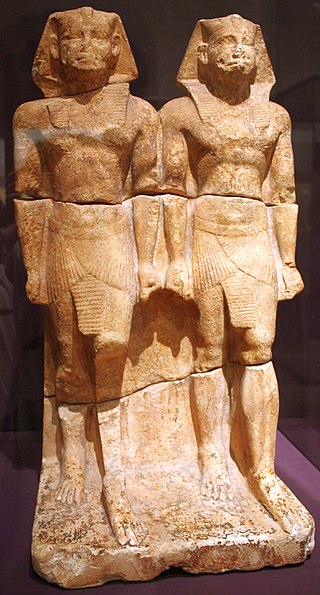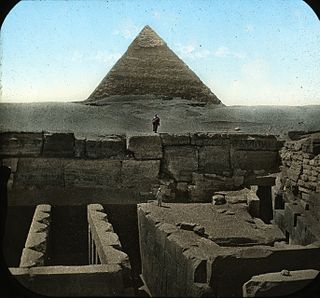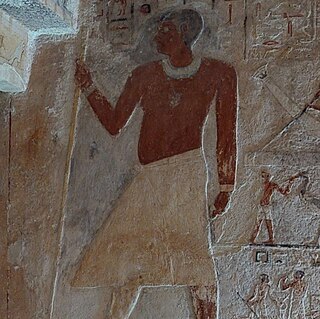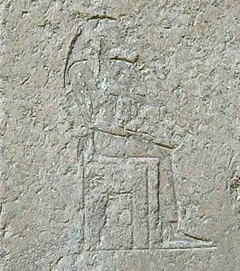
Neferirkare Kakai was an ancient Egyptian pharaoh, the third king of the Fifth Dynasty. Neferirkare, the eldest son of Sahure with his consort Meretnebty, was known as Ranefer A before he came to the throne. He acceded the day after his father's death and reigned for eight to eleven years, sometime in the early to mid-25th century BCE. He was himself very likely succeeded by his eldest son, born of his queen Khentkaus II, the prince Ranefer B who would take the throne as king Neferefre. Neferirkare fathered another pharaoh, Nyuserre Ini, who took the throne after Neferefre's short reign and the brief rule of the poorly known Shepseskare.

Menkauhor Kaiu was an Ancient Egyptian pharaoh of the Old Kingdom period. He was the seventh ruler of the Fifth Dynasty at the end of the 25th century BC or early in the 24th century BC.

Djedkare Isesi was a pharaoh, the eighth and penultimate ruler of the Fifth Dynasty of Egypt in the late 25th century to mid-24th century BC, during the Old Kingdom. Djedkare succeeded Menkauhor Kaiu and was in turn succeeded by Unas. His relationship to both of these pharaohs remain uncertain, although it is often conjectured that Unas was Djedkare's son, owing to the smooth transition between the two.

Nyuserre Ini was an Ancient Egyptian pharaoh, the sixth ruler of the Fifth Dynasty during the Old Kingdom period. He is credited with a reign of 24 to 35 years depending on the scholar, and likely lived in the second half of the 25th century BCE. Nyuserre was the younger son of Neferirkare Kakai and queen Khentkaus II, and the brother of the short-lived king Neferefre. He may have succeeded his brother directly, as indicated by much later historical sources. Alternatively, Shepseskare may have reigned between the two as advocated by Miroslav Verner, albeit only for a few weeks or months at the most. The relation of Shepseskare with Neferefre and Nyuserre remains highly uncertain. Nyuserre was in turn succeeded by Menkauhor Kaiu, who could have been his nephew and a son of Neferefre.

Minkhaf I was an ancient Egyptian prince of the 4th Dynasty. He was a son of Pharaoh Khufu, half-brother of Pharaoh Djedefre and elder brother of Pharaoh Khafre. His mother may have been Queen Henutsen. Minkhaf had a wife and at least one son, but their names are not known. Minkhaf served as vizier possibly under Khufu or Khafre.
Djedefhor or Hordjedef was a noble Egyptian of the 4th Dynasty. He was the son of Pharaoh Khufu and his name means "Enduring Like Horus".

Kawab is the name of an ancient Egyptian prince of the 4th Dynasty. He was the eldest son of King Khufu and Queen Meritites I. Kawab served as vizier and was buried in the double mastaba G 7110–7120 in the east field which is part of the Giza Necropolis.
Khufukhaf I was an ancient Egyptian prince and vizier of the 4th Dynasty.
Khamerernebty II was an ancient Egyptian queen of the 4th Dynasty. She was a daughter of Pharaoh Khafre and Queen Khamerernebty I. She married her brother Menkaure and she was the mother of Prince Khuenre.
Nefermaat II was a member of the Egyptian royal family during the 4th Dynasty and vizier of Khafre.

Khentkaus I, also referred to as Khentkawes, was a royal woman who lived in ancient Egypt during both the Fourth Dynasty and the Fifth Dynasty. She may have been a daughter of king Menkaure, the wife of both king Shepseskaf and king Userkaf, the mother of king Sahure. Some suggest that she was the regent for one of her sons. Perhaps, in her own right, she may have been the king of Upper and Lower Egypt, which aspects of her burial suggest. Her mastaba at Giza – tomb LG100 – is located very close to Menkaure's pyramid complex. This close connection may point to a family relationship. Although the relationship is not clear, the proximity of the pyramid complex of Khentkaus to that of king Menkaure has led to the conjecture that she may have been his daughter.
Sabef was an ancient Egyptian official under king Qa'a in the First Dynasty.
Sekhemkare was a vizier from the Fifth Dynasty of Egypt. He was a son of king Khafre and queen Hekenuhedjet. He served as vizier during the beginning of the next dynasty, during the reigns of Userkaf and Sahure. Sekhemkare is the only son of Khafre whose death can be fairly securely dated to a precise reign, here that of Sahure.
Khufukhaf II was an ancient Egyptian high official during the Old Kingdom period. Likely born during the 4th Dynasty, Khufukhaf died during the reign of pharaoh Nyuserre Ini of the mid 5th Dynasty. In modern Egyptology, he is also called Khufukhaf B or Khufukhaf the Younger to distinguish him from his probable father or grandfather Khufukhaf I.
Nimaathap II was an ancient Egyptian queen suggested to have lived during the Fifth Dynasty of the Old Kingdom of Egypt.

Metjen was an ancient Egyptian high official at the transition time from 3rd Dynasty to 4th Dynasty. He is famous for his tomb inscription, which states that he worked and lived under the kings (pharaohs) Huni and Sneferu.
Kaemtjenent was an ancient Egyptian official under pharaoh Djedkare Isesi in the late Fifth Dynasty, during the Old Kingdom period.
Seshathetep, also called Heti, was an ancient Egyptian official at the beginning of the Fifth Dynasty. Seshathetep held many important titles, possibly including that of vizier. With this latter title, he would have been the most important official at the royal court, second only to the king. He also bore the title of king's son of his body, yet it is doubtful that Seshathetep was the real son of a king.
Qar was an official of the Sixth Dynasty of Egypt. Son of Idu, he probably lived and served between Merenre I and Pepy II.
Idu was an official during the Sixth Dynasty, buried in Giza East Field, tomb G7102. He probably lived and served during the reign of Pepi I Meryre. He is the father of Qar whose tomb is nearby and Bendjet, buried in G7215.








